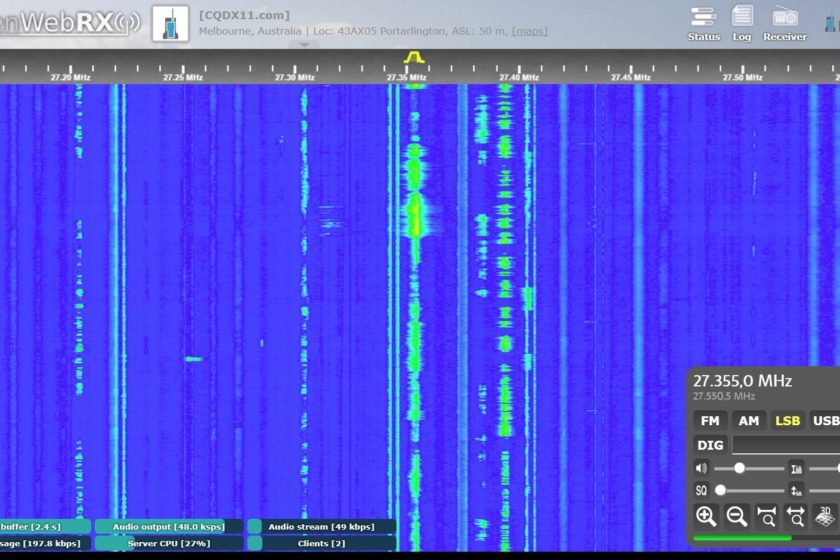
RTL-SDR Software
General Purpose RTL-SDR Software
General purpose SDR software as programs that allow the RTL-SDR to work like a normal wideband radio receiver.
SDR# (Windows) (Free)
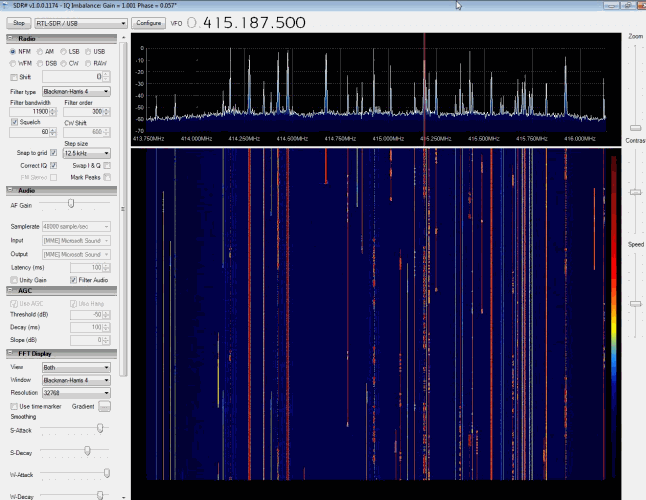
SDR# (pronounced “SDR Sharp”) is the most popular free RTL-SDR compatible software in use at the moment. It is relatively simple to use compared to other SDR software and has a simple set up procedure. We have a full overview of the installation procedure on our Quick Start Page. SDR# is designed to be use with the $199 Airspy SDR, but works just fine with the RTL-SDR.
SDR# is a simple to use program that also has some advanced features. It has a useful modular plugin type architecture, and many plugins have already been developed by third party developers. The basic SDR# download without any third party plugins includes a standard FFT display and waterfall, a frequency manager, recording plugin and a digital noise reduction plugin. SDR# also decodes RDS signals from broadcast FM.
HDSDR (Windows) (Free)
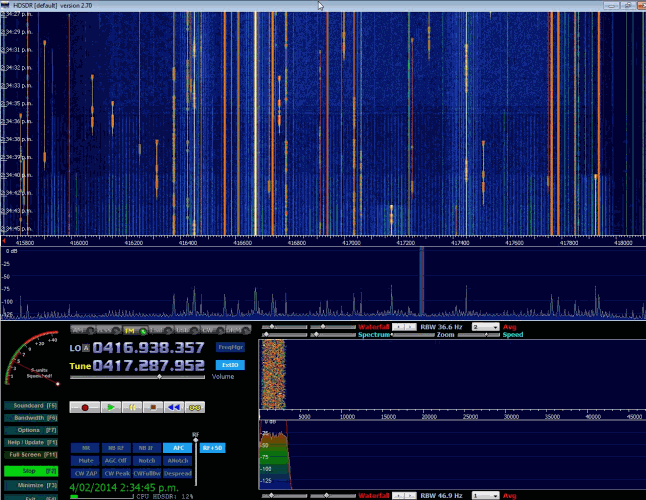
HDSDR is based on the old WinRAD SDR program. HDSDR supports the RTL-SDR through use of an ExtIO.dll module. To install HDSDR, download the program from the link on the main HDSDR page, then to use the RTL-SDR you will need to download the ExtIO_RTL2832.dll file an place it into the HDSDR folder. When opening HDSDR, select the newly copied ExtIO_RTL2832.dll. The other dlls that come with HDSDR will not work with the RTL-SDR, even though they have RTL-SDR in their filename. The official installation instructions can be found here.
Along with a FFT display and waterfall, HDSDR has some extra advanced features. Users will also find an Audio FFT and waterfall display on the bottom of the screen. The output audio can also be bandpass filtered by dragging the filter borders on the display. Bandpass filtering the audio can really help clean up a noisy signal. The audio processing also supports placing of notch filters either manually or automatically. There are also noise reduction and noise blanker features and an automatic frequency centering algorithm which will automatically center the signal, so you don’t need to click exactly in the center of a signal. Traditional ham radio users will also enjoy the S-units signal strength meter and the built in frequency manager.
SDR-RADIO.COM V2/V3 (Windows) (Free)
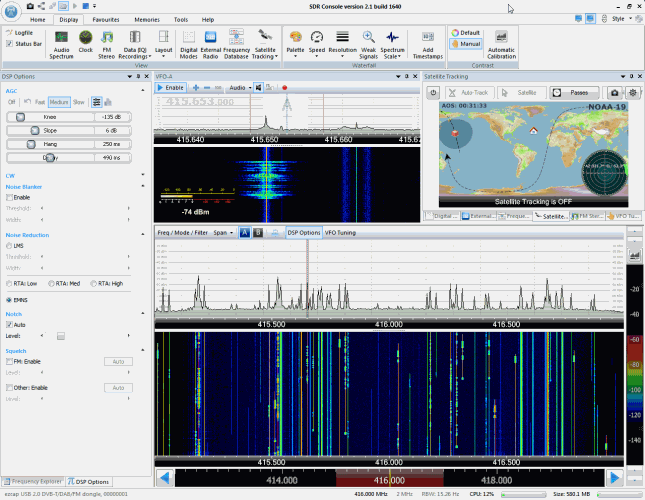
SDR-RADIO.COM V2 and the newer V3 is a popular SDR program with many advanced features. As such is it a fair amount more difficult to learn and use compared to SDR# and HDSDR. Be sure you install version 2 and not V1.5 as only V2 has RTL-SDR support.
Once sdr-radio is installed, to get it working with the RTL-SDR you will need to compile or download three .dll files (SDRSourceRTL2832U.dll, rtlsdr.dll and libusb-1.0.dll) and place them into the sdr-radio folder. To compile your own dlls see the instructions here, otherwise download the dlls directly from the bottom of this link. If the dlls were placed in the correct folder you will be able to add your RTL-SDR as a receiver by clicking on the +Definitions button, and then finding and adding the RTL SDR (USB) option under the search drop down menu.
Like HDSDR, not only does sdr-radio have a RF FFT signal and waterfall display, but also an optional audio spectrum FFT and waterfall display. Built in are also several DSP features like a noise blanker, noise reduction filter, notch filter and squelch options. The EMNS noise reduction filter is particularly good at automatically cleaning up and clarifying voice signals.
To add to the feature list, sdr-radio also has built in PSK, RTTY and RDS decoders, and also comes with a satellite tracker. Furthermore, sdr-radio V2 (not V3 yet) has an excellent remote server which will allow you to easily set up and connect to a remote RTL-SDR server over a network or the internet. Finally, sdr-radio is capable of listening to up to 6 signals in the same chunk of visible spectrum at a time.
Linrad (Windows/Linux/Mac) (Free) (Related Post)
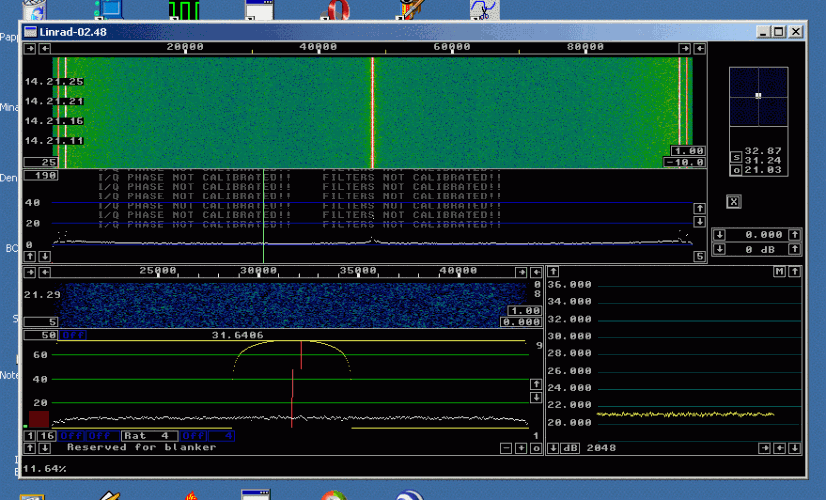
Linrad is a free advanced SDR program with a steeper learning curve compared to most other SDR programs. Many users prefer to use Linrad as it can be set up to have a very high amount of information density on the screen and it also has an advantage with receiving signals with the E4000 tuner as it can be made it run in a special linearity mode which significantly improves the dynamic range.
Linrad also has some very advanced features not found in most other SDR receivers. It has multi-frequency interval I/Q correction, a very powerful “smart” noise blanker, multicast output, weak signal optimized waterfall, settings to aid in taking performance measurements, two RF channel input, superior AGC and an adaptable automatic frequency controller (AFC). Linrad is probably the software most superior in terms of actual signal processing performance.
To install Linrad on Windows first download and run the setup-dll installer, and then download and extract the actual Linrad program. You will need to go through a text based set up at the very beginning.
GQRX (Mac/Linux) (Free)
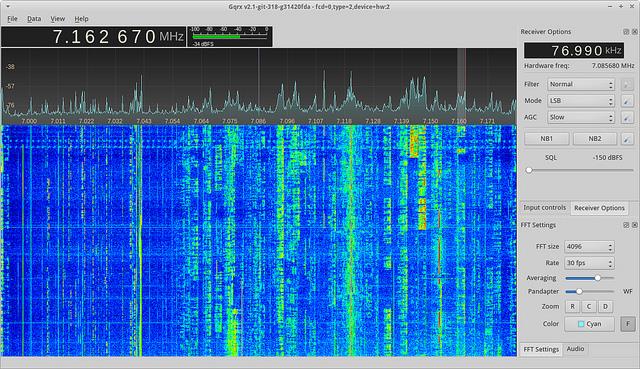
GQRX is a free simple to use SDR receiver which runs on Linux and Mac systems. It is similar to SDR# in terms of features and simplicity of use. GQRX comes with a standard FFT spectrum and waterfall display and a number of common filter settings.
CubicSDR (Linux/Windows/Mac) (Free)
A new cross platform SDR receiver which is based on the liquid-dsp libraries.
Studio1 (Windows) (Paid)

Studio1 is a non-free commercial SDR receiver with advanced DSP capabilities, and is claimed to have the lowest CPU usage of any general purpose SDR software. Studio1 supports the RTL-SDR through use of an ExtIO.dll module.
Studio1’s claims that it has a very efficient DSP engine that can run well on older Pentium 4 machines.
SDRUno (Windows) (Free) (Related Post)
SDRplay have now acquired the rights to Studio1 and have released a free version of it called SDRUno. SDRUno is designed mostly for use with SDRplay units, but have added compatibility with RTL-SDR units, up to a maximum bandwidth of 2 MHz. It is essentially the same as Studio1.
A fairly feature rich piece of software, although the interface can be a bit clunky and difficult to use at times.
ShinySDR (GNU Radio) (Free) (Related Post)
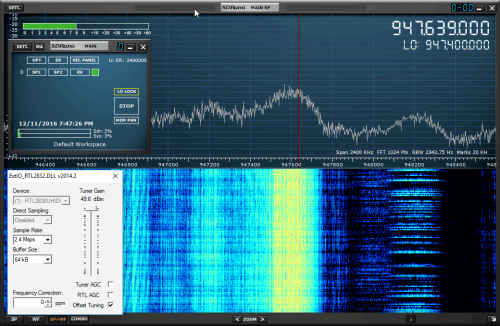
ShinySDR is an SDR application built in GNU Radio with a web based interface. Since ShinySDR is controlled via a web interface it can easily be controlled over a network or the internet. It also has a plugin type development feature which allows demodulators to be easily written and integrated.
The current main technical advantage to ShinySDR is that it has a persistent waterfall, meaning that the waterfall can be moved, zoomed and re-tuned without loss of any history like in other SDR software.
This is only a sample of the software available for RTL-SDR USB Dongles from
https://digitalxradio.com/2017/12/08/big-giant-list-of-free-rtl-sdr-software/
This is an ever expanding field in which many people are contributing a lot of time and effort towards constant improvement.
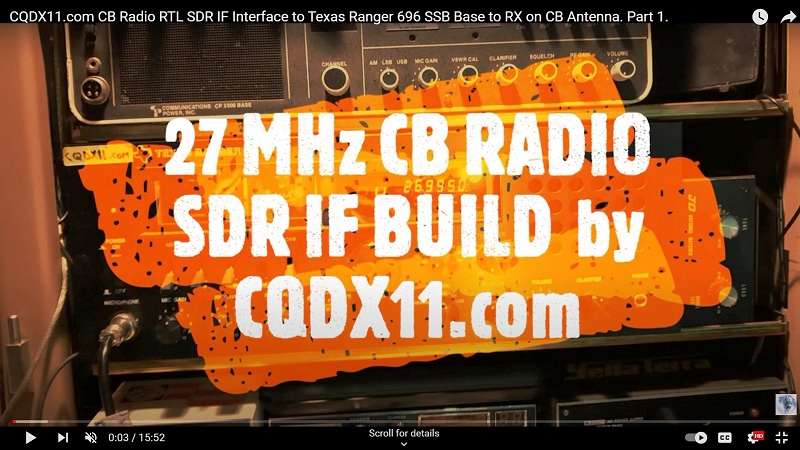
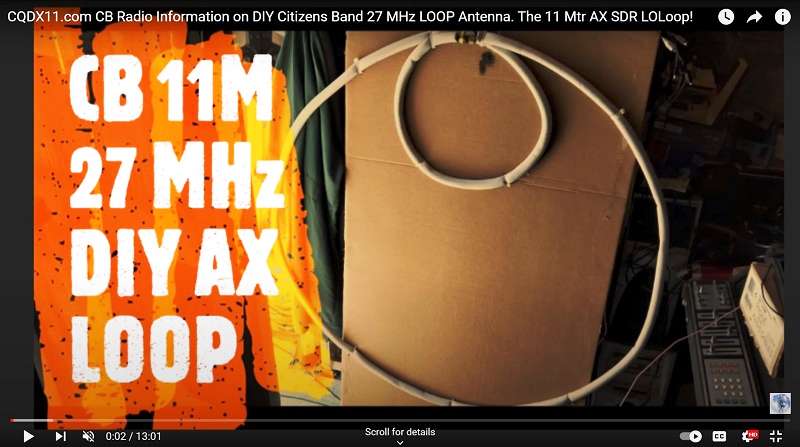


I personally am using SDRuno a lot as I like the performance and the presentation for Live Facebook CB radio streams when DX skip is running. I post these Streams on my sites including https://www.facebook.com/groups/AllRadioSDRAction/